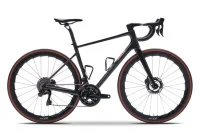Tubeless Road Tire Technology
A version![]() of this article was originally
of this article was originally
published in Triathlete Magazine
Dear Tech Support,
The group I ride with has been debating whether a higher or a lower tire pressure minimizes rolling resistance – what’s the answer?Also, one of us has “gone tubeless” and is raving about the ride.I want to know is whether it’s hype or a real performance enhancer for us middle of the packers?
Chris F., via email
Dear Chris,
First, while the maximum listed pressure on some tubular tires can be around 200 psi., you will only increase rolling resistance, and the likelihood you will need to find a good chiropractor, by filling them to this level. While super high tire pressure may work well on a velvety smooth velodrome, even a freshly paved road does not even remotely approach this level of smoothness and thus tire pressure should be adjusted accordingly.
You should never exceed the maximum recommended pressure listed on a tire.Even if a tire’s maximum range is much higher, 100-130 psi is an optimal pressure for most performance road tires.Lighter riders (under 140 lbs) usually do better on the low end of this range and heavier riders (over 170 lbs) more towards the higher end.
How can rolling resistance decrease with moderate tire pressure compared to over-inflation?More than absolute pressure, tire rolling resistance is about consistency of contact patch between the tire and the road.When skipping and point loading over surface imperfections in the road occurs with an over-inflated tire, the tire casing deforms more and contact between the road and tire becomes less consistent.This, in turn, increases rolling resistance.
Second, Road Tubeless brings road bike tire technology into the modern era of tire design. Road Tubeless works on the same proven tubeless tire principles that performance motorcycle, car and mountain bike tires have used for years.A Road Tubeless system uses a specially configured carbon fiber/rubber bead, in combination with a matching rim shape, to create an air tight seal and eliminate the need for a tube.The end result is the best riding tire system I have had the pleasure of riding.
Some common questions and answers regarding Road Tubeless are:
“What are the direct benefits of Road Tubeless compared to traditional clincher and tubular tire designs?”
- Significant enhancement in comfort and vibration damping. When you lower rolling resistance and tire pressure simultaneously, wheels ride better.
- Excellent handling and traction characteristics. The casing on a tubeless tire provides excellent consistency of contact patch with the road and little deformation under load.
- The elimination of pinch flats, even when riding only 80 psi on rough dirt with a road tire.
- Low rolling resistance. When a friction layer (like a tube or tubular glue) is eliminated, lower rolling resistance can be a result.
- Like a well glued tubular, Road Tubeless is very unlikely to roll off the rim in the event of a high speed puncture.
- They hold air longer than average and require less reinflation.
- Easy to repair. In the event of a flat, a standard clincher tube can be used in a Road Tubeless tire. Also, much like a car tire, a sliced tubeless tire can often be “plugged” and resealed again if damaged.
For short distances or long, Road Tubeless offers a number of potential benefits.
“Are Road Tubeless difficult to install?”
Road Tubeless tires fit on the rim looser than many clincher tires and frequently do not even require a tire lever.If you do use a tire lever, a tubeless compatible one is recommended so that you do not damage the tire bead.Anyone who is comfortable doing general maintenance on their bike should find the process reasonably straight-forward.Road Tubeless tires install best when liquid tire sealant is used in conjunction with a quick burst of air from a compressor or CO2 cartridge to catch and seal the bead of the tire to the rim firmly and quickly.
“What tires and wheels work with Road Tubeless and what do they cost?”
There is currently one tire – the Hutchinson Fusion 2 Tubeless – that offers the unique carbon/rubber tire bead matrix that can seal with a rim adequately to hold air.Luckily, the Fusion 2 Tubeless is a very well thought out and strong performing tire.
When it comes to wheels, things get a little more complicated.The only officially approved Road Tubeless wheel on the market is Shimano’s Dura Ace level 7850-SL. The rim on the 7850-SL has a bead and outer rim wall/valve that is designed to directly match up with the Fusion 2 Tubeless tire ideally.
This being said, companies like Stan’s No Tubes have researched using Hutchinson Fusion 2 Tubeless tires with a number of rim combinations and concluded that most any standard clincher rim can be reliably adapted to Road Tubeless with one of their rim sealing kits. Wheels with sealed outer rim walls, like Mavic’s venerable Ksyrium and R-SYS, do not even require using special rim tape to convert; a special valve and some sealant is all that is needed. A step-by-step instructional video on Road Tubeless installation and conversion can be found at www.notubes.com.
Tubeless conversion kits run $30-$70, depending on the wheel. Hutchinson Fusion 2 Tubeless tires are under $70 each, similar to a high quality clincher and ultra light tube.
“Aren’t Road Tubeless tires heavy?”
No. While not the absolute lightest tire design, a Hutchinson Fusion 2 Tubeless is a competitively weighted tire at 290 grams (only about 20 grams more than a lightweight clincher and ultra light tube). With time, tubeless may even become lighter as the Fusion 2 Tubeless tire is the first generation of tubeless design while clincher and tubular tires are decades into their evolution.
“If the tubeless concept has been around for a while and works so well, why isn’t everyone using Road Tubeless?”
Some big tire companies refusing to participate and perception versus reality.
A number of tire companies originally competed to create the Road Tubeless tire standard.When Hutchinson’s design won, many other companies decided that instead of adopting the standard, they would simply not produce anything.This would increase the likelihood that the Road Tubeless concept would not gain much consumer momentum and would thus gather dust until Hutchinson’s patent expired.
Also, Road Tubeless tires, with their exceptionally smooth ride, will make some riders automatically assume that a firmer feeling clincher or tubular is faster. As long as “Feels faster” wins out over “Is faster”, many riders will shy away from new technology and many manufacturers will continue down the road they always have ridden.
Road Tubeless is well worth consideration by any cyclist or triathlete who is looking for an improvement over high performance clincher tires.Regardless of how short or how long your rides or events, Road Tubeless is affordable technology that works.
Ride hard and smart.
Ian









